Question
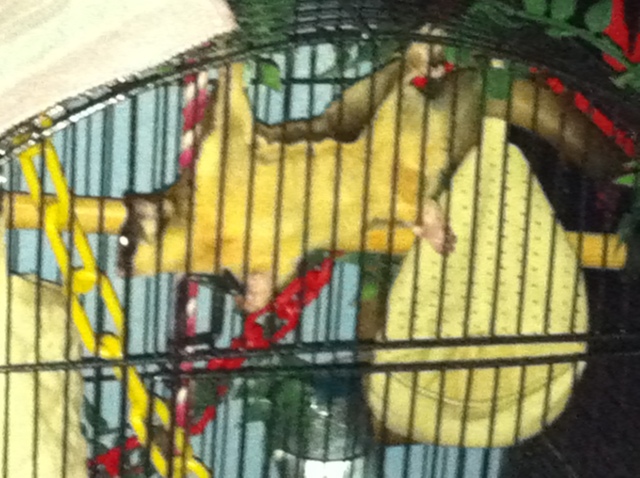 Glider KK
Glider KK
Hi Kaden, i'm jeremy, just started to keep gliders in Jan 2011. My sister got the pairs for my birthday from illegal sellers as my country prohibits them, thus no vets nor products on them. I couldn't get any information on the age nor the parentage on them, the only thing i observe is they are quite attached to one another when they came. The male just started to show signs of balding on its head maybe you could tell me how old is it. Overall, I'm still quite unsure of what am i doing with the housing, diets and health.
Furthermore another male glider KK(king kong) came into the family. It was brought by my younger brother without my knowledge and he couldn't handle it so he pass it to me. Not much detail was known again. Was told that it was 6 months old, fed with hamster dry food and fruits daily, reason was it was the last glider as the rest are sold away, also it's the main breeding male. What I observe was yes it was very active and tame, doesn't crab much.
If i'm correct with my glider's age it should be around 3 months+(signs of balding?) but the KK; 6 months; was at least 1.5 times bigger. I don't think 3 months difference could be that big, unless the diets I'm using was wrong compare to his hamster food? Please tell me I'm not wrong. Mines' still so small in size. I think the seller is lying and doesn't know much about KK's age. Can a 6 month glider breed? Is his glider overweight?(I've attached a picture of it below).
The seller also mention that he keeps on "pump" the glider with foods every night to keep him up for breeding. And true enough KK doesn't eat my BML nor meal worms much. I start to worry. Should i change it's diet to my BML straight or slowly?
KK's color of the white underside was permanent dirty yellow which i guess was urine stains and the black color side was smudge with yellow too. I couldn't washed it off by bathing it and spraying it with glider shampoo. Came along with a very very strong odor too which i then understand why my brother doesn't want it anymore. I guess the odor is caused by it's diets(hamster food) and overweight? How can I remove or lessen the smell? It's really strong and my present pair attain the smell from it when i put it together for a few days before i separate them from KK. My pair doesn't smell that bad before it came. Is it because my pairs is not that old to attain that kind of odor yet? can i get rid of the "pee" smell?
Food i feed everyday -> BML 1 frozen cube for 3 gliders(used to be 1 cube for 2 gliders), 1 small portion of fruits. Once a day.
Everyday Wed and Friday will be meal worms and yogurt mixed with some juice or meal worms and fruits. The meal worms are dusted with rep-calcium. no staple dry food. Was told by a vet assistant with 10 years experience that my diet is weird and asked me to use cat food, i was thinking maybe cat food as staple food. But i scare the gliders wouldn't eat the BML diet anymore. I feed a few sticks of dry meal worms of treats everyday.
And lastly should i house them together? For the few days when i house them together i notice that KK was pestering my female glider which caused her to crab. And i scare fighting and snatching of food leading to malnutrition or stress.
Sorry for my messy paragraphing and shooting question everywhere. I'm just concerned. Really appreciate and thank you for reading my question.
Thanks
AnswerHi Jeremy :)
Greetings from the USA
To be perfectly honest there are soooo many different sugar glider diets out there it is totally understandable that new owners get so confused..!!
A good starter suggestion is to stay away from pelleted foods..ESPECIALLY CAT FOOD..!! This used to be the "old" way of feeding gliders.. but the entire idea was horrible from the get go.. sugar gliders eat nectar in the wild.. not pellets.. so keeping with a traditional liquid diet is always advisable..
The most popular diets that you will most likely come across on the internet are the BML & the Original Ledbeaters Diets.. I personally feed a modified Ledbeaters myself & have yet to experience ANY ISSUES with either my personal Gliders or any rescues we have had turned in.. This has worked wonders for us for many years now.. not only is it easy..!! but if doubled up it will make enough to freeze into smaller containers for a month or more depending on how many gliders you own.. one thing to note is this does NOT expand when frozen so no worries about filling it right up to the top..!!
My Mixture is as follows:
1/2 c Juice (anything all natural or no sugar)
1/2 c Honey
1 Boiled Egg (with shell)
1/2 c baby cereal (rice/oatmeal/mixed)
1 jar chicken/turkey baby food
1/2 c Wheat Germ
1 tsp Calcium (NO PHOSPHOROUS no D3)
1/2 tsp Vionate Multi-Vitamin
1 tsp of GliderAde (if avail but not necessary)
The CALCIUM & VIONATE will usually NOT BE FOUND in a local pet shop
and therefore will need to be ordered online..
I have successfully used the following companies:
PetRX.com = http://www.petrx.com/search.aspx?find=vionate
ReptileSupply.com = http://www.reptilesupply.com/product.php?products_id=119 or http://www.reptilesupply.com/product.php?products_id=2670
Of course we also feed either FRESH or FROZEN Veggies 4 or more times a week as well as a variety of fresh fruits and meal worms on occasion as a treat..
The key is to think VARIETY.. meaning that unlike your average cat or dog our suggies LOVE VARIETY in their diets.. they don't like the BORING and ROUTINE..!! So feel free to switch things up from time to time.. Like the FLAVOR of juice you use in the mixture.. some nights give them a little cottage cheese.. or applesauce..
But stay away from the following:
Nuts (or any high fat content foods)
Lettuce
Cheese (or any dairy other than yogurt)
Corn (or any foods where the Phosphorus ratio is higher than the calcium ratio)
Bird seeds or parrot food
Grapes
and of course Chocolate..!!
I think that no matter which diet one chooses as long as the basic protein / calcium ingredients are there for the optimum health of the glider each one should be nutritionally balanced & complete overall.
Your "smelly" glider is most likely that way because of his diet.. after a few months he should mellow out on the smell.. switch him over gradually if he exhibits refusal to the new ledbeater's mix.. I personally have never seen a glider refuse it.. as a general rule it should be one ice cube sized portion PER GLIDER..
Regarding your other questions..
When gliders reach sexual maturity is somewhat variable, but as a general rule females become sexually mature aroung 8-12 months of age, and males at 12-15 months.
this is also true for the males in developing their scent glands.. it varies.. most likely he is an older male b the looks of him.. gliders usually are white underneath & yellow as they get older.. so either I would say that this guy you have pictured is older.. or has been in awful cage conditions.. in any even that yellow discoloration can not be removed..
The weight issues are from the hamster foods.. there is a LOT of fat content in those sunflower seeds..!! Try giving them a smaller hamster wheel in the cage.. that will supply them with lots of exercise..:)
Also you would want them caged separately but next to each other is you want to prevent breeding them..
Please feel free to keep in touch.. I would LOVE2Hear what your little ones thinks about it all..!!
O_o kaden


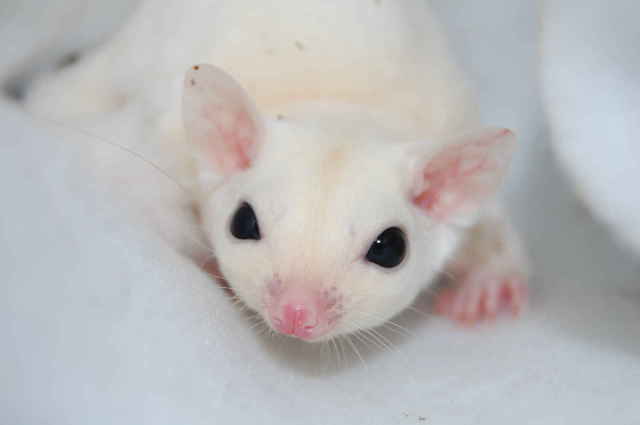 Does Sugar Gliders will effect our health?
QuestionHi Kaden,
I would like to know if sugar glider
Does Sugar Gliders will effect our health?
QuestionHi Kaden,
I would like to know if sugar glider
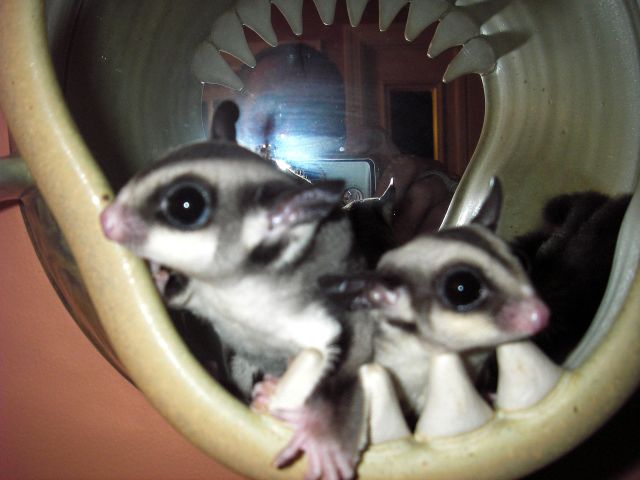 Joeys
Questionsampson and delilah
QUESTION: Hi,
Unfort
Joeys
Questionsampson and delilah
QUESTION: Hi,
Unfort
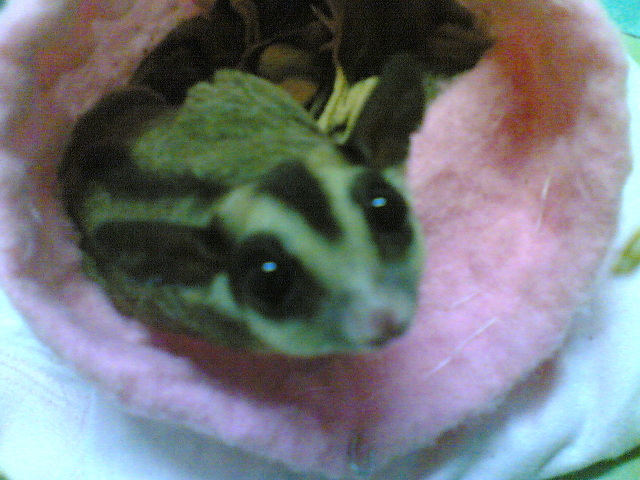 Wild caught sugar glider.
QuestionQUESTION: Hi...Im from Malaysia. Recently, my u
Wild caught sugar glider.
QuestionQUESTION: Hi...Im from Malaysia. Recently, my u
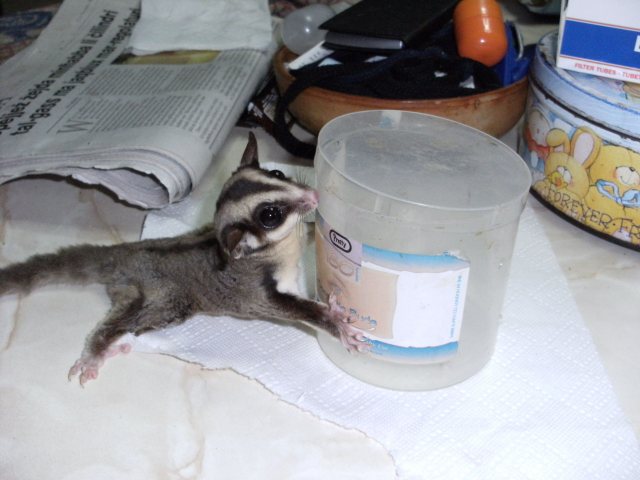 Baby sugiess
QuestionKila
QUESTION: Hello my name is Jan and
Baby sugiess
QuestionKila
QUESTION: Hello my name is Jan and
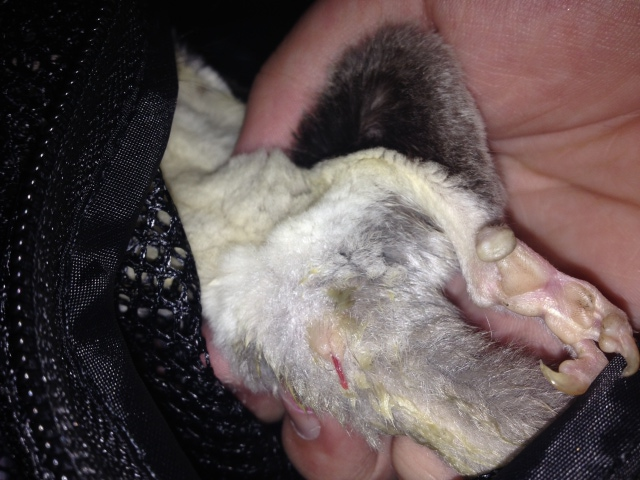 Puberty
Question
His genitalia Wont eat
I got two
Puberty
Question
His genitalia Wont eat
I got two